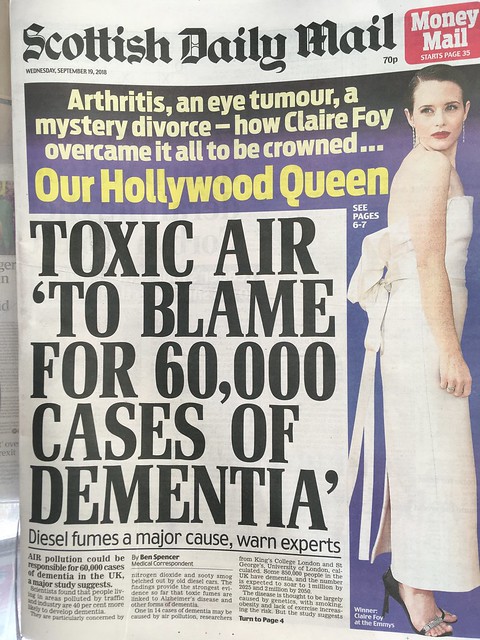...like the 20mph zones, and the "turn off engine at standstill" signs - how is this going to be effectivley policed?
CityCyclingEdinburgh Forum » Debate!
"Air pollution in Scotland 'creating public health crisis' "
(298 posts)-
Posted 7 years ago #
-
rider73 - the LEZ in London involves a ring of Automatic Number Plate Recognition cameras placed at entry points of the zone. Using the DVLA database, TfL has created a "black-list" of vehicles that do not meet the emission requirements of the zone. If they drive into the zone then a penalty charge notice is issued to the owner.
Not saying that is what will happen in Glasgow - but it is all technically feasible.
Posted 7 years ago # -
Diesel cars will be required to have Euro 6 engines, which were introduced four years ago.
Petrol cars will require Euro 4 engines, introduced in 2005.
So hardly changing anything that wouldn't have happened anyway, since in 2022 all diesel cars under 8 years old and all petrol cars under 17 years old (!) will meet the requirements.
Political hot air.
Posted 7 years ago # -
Indeed the list of vehicles which would require banned to comply with the headline "all but cleanest vehicles" would leave a lot of space for cycling.
Even if they mean motor vehicles then the published standard is hot air as neddie says.
I wonder how many 17 year old cars come even close to meeting the standard they did when manufactured irrespective of the fact that they probably didn't meet the required standard even when brand new.
Posted 7 years ago # -
In respect to Nitrogen dioxide and tiny sooty particles the pollution (the things that have caused the limits to be exceeded and health concerns) a 17 year old petrol car is probably cleaner than a brand new diesel car even accounting for some loss of efficiency.
Posted 7 years ago # -
Old petrols are typically cleaner than new diesels in respect to NOx and PMs the things exceeding pollution targets and thought to be related to lung disorder. An old petrol would have to be very out of shape to get near a new diesel in respect to local pollution.
2003 Vauxhall Vectra 1.8 petrol NOx:16 mg/km
2017 Ford Focus 1.5 diesel NOx:52 mg/km
The Pms very likely to be lower in old petrol as well.
To be silly if the government banned cars under 17 year old the average car would probably be cleaner (lower NOx) as would be lower percentage of diesel cars.
Posted 7 years ago # -
“.
ENVIRONMENTAL experts have quit a group set up to oversee ministers’ strategy for tackling air pollution, citing frustration and deep disappointment over a lack of progress.
In a major blow to the First Minister, experts advising Nicola Sturgeon on how to reduce pollution in Scotland have quit her clean air strategy team.
“
Posted 7 years ago # -
https://mobile.twitter.com/sustransscot/status/986242057982406657
The Scottish Parliament debate on the Air Quality in Scotland inquiry is starting now. We will be following the debate and reporting key comments this afternoon.
Further updates on the debate on the Sustrans twitter account.
Posted 7 years ago # -
'Impossible-to-cheat' emissions tests show almost all new diesels still dirty
Other new research shows diesel vehicles cause 88% of the £6bn annual damage to people’s health from car and van exhaust in the UK
Posted 7 years ago # -
Transform Scotland @TransformScot
BREAKING: New @scotgov stats show that transport emissions *increased* in 2016 for the 3rd year in a row. @scotgov failure to cut car emissions means transport is the largest source of emissions in Scotland and now accounts for *37%* of national emissions
Posted 7 years ago # -
Grim reading:
"Transport emissions have increased by 2.3 per cent from 2015 to 2016. Transport emissions decreased by 2.5 per cent from 1990 to 2016. The increase in emissions in 2016 was mainly due to an increase in emissions from road transport, in particular passenger cars and light duty trucks.
In 2016, road transport was the largest source of emissions in Scotland. Road transport emissions have increased by 7 per cent between the 1990 and 2016; this is due to a growth in activity over the period offset partly by improvements in the efficiency of vehicles."
Posted 7 years ago # -
Not a single mention of transport emissions in this Beeb Scotchland article except the quote from Green MSP Mark Ruskell.
They do at least acknowledge that most of the reduction in CO2 is down to closing Longannet power station.https://www.bbc.co.uk/news/uk-scotland-44453764
Mr Ruskell:
"...we need to see action from government to reverse the worrying trend of rising numbers of cars on our roads driving an increase in transport emissions. Government needs to give up on building more roads and trying to give airlines tax breaks. Instead it needs to listen to the public and fix the roads we already have, and invest in up-to-date buses, trains and cycle lanes to help people get on with their daily lives."Posted 7 years ago # -
Also worth highlighting that, within the transport heading, emissions from international shipping and aviation have increased by 39.7% since 1990. So much for the devastating impact of Air Passenger Duty.
Posted 7 years ago # -
It would appear that offshore emissions are not included in any of the statistics. So, flaring of gas from oil rigs not included? In which case, CO2 estimates may be wildly underestimated. Though presumably they may be included in UK-wide emissions.
Posted 7 years ago # -
More on gas and oil here:
---
In financial year 2016-17, oil and gas production in Scotland (including Scottish adjacent waters) is estimated to have been 74.7 million tonnes of oil equivalent (mtoe).
Production in Scotland increased by 2.9% compared to 2015-16, and accounted for 82 per cent of the UK total (up from 80 per cent in 2015-16).
In 2016-17, oil and gas fields in Scotland accounted for 96 per cent of UK crude oil and natural gas liquids (NGL) production, and 63 per cent of UK natural gas production.
---
http://www.gov.scot/Topics/Statistics/Browse/Economy/oilgas1617
Here's a figure from UK Oil & Gas's CO2 emissions for 2016:
"In 2016, the UKCS emitted 13.1 million tonnes of CO2. This is comparable to Norway which released a total of 13.3 million tonnes of CO2, down from 13.5 in 2015. However, Norway’s production was over twice that of the UK’s in 2016 and produced at a lower carbon intensity. "
https://oilandgasuk.co.uk/wp-content/uploads/2017/12/Environment-Report-2017.pdf
If Scottish share of production is indeed 96% of oil, and 63% of gas, then maybe 70% or more of that 13.1 million tonnes of CO2 emissions can be attributed to Scotland.
From the Scot Gov report:
"In 2016, Scottish emissions of the basket of seven greenhouse gases are estimated to be 38.6 million tonnes carbon dioxide equivalent (MtCO2e)."
So, add maybe 9.5 million tonnes CO2 to account for offshore oil and gas extraction emissions. We get around 48 million tonnes of CO2 for 2016.
Posted 7 years ago # -
New editor -
 Posted 7 years ago #
Posted 7 years ago # -
“
Governments must accept the stark fact that cars must be removed from the street altogether“
https://www.theguardian.com/commentisfree/2018/sep/19/cut-air-pollution-car-action
Posted 7 years ago # -
“
Anna Richardson, the city council's convener for sustainability and carbon reduction, said all Glasgow's bus operators would be compliant with the LEZ restrictions when it comes into force without the need to curtail services.
“
Posted 7 years ago # -
Musselburgh High Street now has a wall of grass to try to reduce pollution. Quote: "The four-metre high vertical wall features more than 1,600 pots of moss inside the structure and its Dresden-based creator claims it will collect the same amount of pollutants as 275 ‘normal’ trees in a similar area".
Posted 7 years ago # -
Is it on the pavement? It would be better in a parking place.
Posted 7 years ago # -
It's on the pavement outside the police station. Maybe to stop it being stolen.
Posted 7 years ago # -
Anything but actually deal with the root cause of the problem
Posted 7 years ago # -
Musselburgh High Street always rammed. There must be a way of avoiding it completely on a bike? Involving a steeper bridge than the one the road takes over the river. I have been over such bridges to north and indeed south of the high street. Pedestrian bridges. Staff in Luca's said there was a route but advised against a non-local attempting it. Looks like the side street at Lorettos would be where you would start. You would maybe emerge at the garage nearer Fisher Row.? Might involve the pub Swanny's? I figured out how to access the Grammar School by bicycle avoiding much of the traffic that is always on the main road. Busy town
Posted 7 years ago # -
If only Musselburgh had a bypass, so that no one needed to drive through the High St.
It would be such an important bypass, one could even call it the "A1" <thinking emoji>
Posted 7 years ago # -
@neddie, that would not work, people are wanting to drive in to Musselburgh. To shop and park.
Wiki says it has two train stations but none of them are near the shops. (the second one is in Wallyford)
Wiki does give many, many bus links.
Somewhat darkly wiki gives the following list of celebrities and their occupations as being born in The Honest Town
Kenny Miller (footballer)
Willie Ormond (Scotland manager)
Yvonne Murray (athlete)
Harry Lauder (popular entrtainer)
Robert Black (serial killer)Posted 7 years ago # -
“
Modern Musselburgh was bypassed by the A1 as recently as 1987, taking it off the main road into Edinburgh for the first time in 1,900 years. But it remains a busy town whose fortunes and property prices have been strongly linked to the the economic boom in Edinburgh. It also remains an attractive town with many interesting buildings, a racecourse, a harbour, and spectacular views across the River Forth and along it towards Edinburgh: plus its own stately home, Newhailes, and the attractive Inveresk Lodge Garden.
“
https://www.undiscoveredscotland.co.uk/musselburgh/musselburgh/index.html
Posted 7 years ago # -
Musselburgh was also in Midlothian until 1973
Posted 7 years ago #
Reply »
You must log in to post.


 posts
posts
